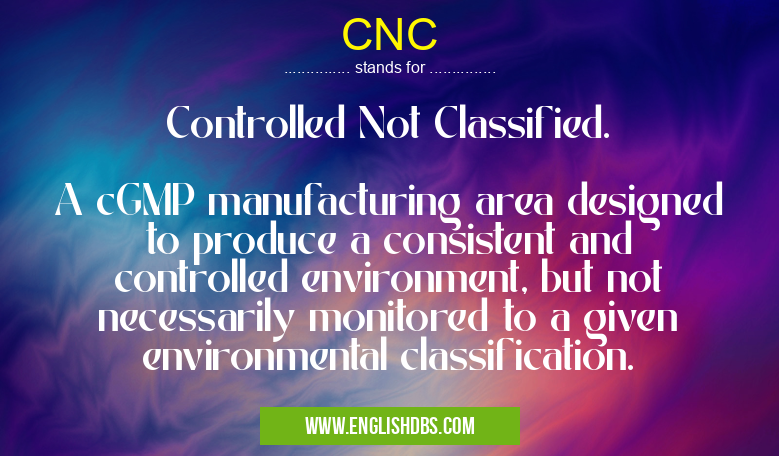What does CNC mean in ENVIRONMENTAL
CNC (Controlled Not Classified) refers to a designated manufacturing area that maintains a consistent and controlled environment, without adhering to specific environmental classifications. This type of area is designed to ensure the production of products that meet specified standards and quality requirements.

CNC meaning in Environmental in Governmental
CNC mostly used in an acronym Environmental in Category Governmental that means Controlled Not Classified. A cGMP manufacturing area designed to produce a consistent and controlled environment, but not necessarily monitored to a given environmental classification.
Shorthand: CNC,
Full Form: Controlled Not Classified.
A cGMP manufacturing area designed to produce a consistent and controlled environment, but not necessarily monitored to a given environmental classification.
For more information of "Controlled Not Classified. A cGMP manufacturing area designed to produce a consistent and controlled environment, but not necessarily monitored to a given environmental classification.", see the section below.
Introduction to CNC
Key Features of CNC Manufacturing
-
Controlled Environment: CNC areas maintain a consistent temperature, humidity, and particulate levels to minimize external influences on the manufacturing process. This controlled environment helps prevent product defects and variations.
-
Not Necessarily Monitored to a Given Classification: Unlike classified environments, CNC areas are not subject to specific environmental standards, such as ISO 14644-1. However, they may still employ monitoring systems to ensure that environmental conditions are within acceptable ranges.
Benefits of CNC Manufacturing
-
Consistency: CNC areas provide a standardized and reproducible manufacturing environment, reducing the likelihood of product inconsistencies.
-
Quality Assurance: The controlled environment minimizes external factors that could compromise product quality, leading to higher yields of defect-free products.
-
Flexibility: CNC areas can be easily adapted to produce a variety of products without the need for major infrastructure changes.
Applications of CNC Manufacturing
CNC manufacturing is commonly used in industries where environmental control is crucial for product quality, such as:
- Pharmaceutical manufacturing
- Semiconductor fabrication
- Electronics assembly
- Precision engineering
- Aerospace
Conclusion
CNC (Controlled Not Classified) manufacturing areas offer a balance between environmental control and flexibility. By maintaining a consistent and controlled environment, CNC areas enable the production of high-quality products that meet specific standards, without the need for stringent environmental classifications.
Essential Questions and Answers on Controlled Not Classified. A cGMP manufacturing area designed to produce a consistent and controlled environment, but not necessarily monitored to a given environmental classification. in "GOVERNMENTAL»ENVIRONMENTAL"
What is the purpose of a Controlled Not Classified (CNC) manufacturing area?
A CNC manufacturing area is designed to provide a consistent and controlled environment for production, ensuring product quality and compliance with industry standards. It is typically used for activities that do not require the same level of environmental monitoring as a fully classified area, such as assembly, packaging, or storage.
What are the key features of a CNC manufacturing area?
Key features of a CNC manufacturing area include controlled temperature and humidity, filtration systems to maintain air quality, and appropriate lighting. It may also have designated areas for specific activities, such as storage and testing.
What types of activities are typically performed in a CNC manufacturing area?
CNC manufacturing areas are suitable for a range of activities that require a controlled environment but not a fully classified one. This may include assembly, packaging, storage, inspection, and testing of products.
What are the benefits of using a CNC manufacturing area?
Using a CNC manufacturing area provides several benefits, including improved product quality and consistency, reduced risk of contamination, and enhanced employee comfort and productivity. It also helps meet regulatory requirements and industry standards.
How is a CNC manufacturing area different from a fully classified area?
While both CNC and fully classified areas aim to provide controlled environments, they differ in the level of environmental monitoring and control. Fully classified areas adhere to specific environmental classifications, such as ISO or GMP standards, and are subject to rigorous monitoring and documentation. CNC areas, on the other hand, do not require the same level of monitoring and control.
CNC also stands for: |
|
| All stands for CNC |
